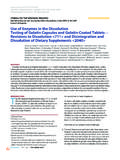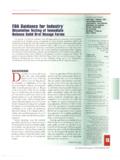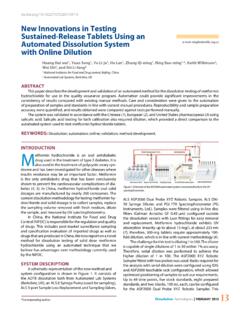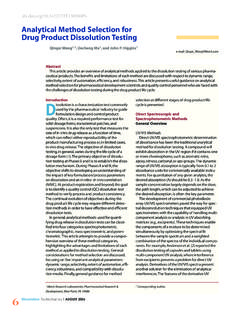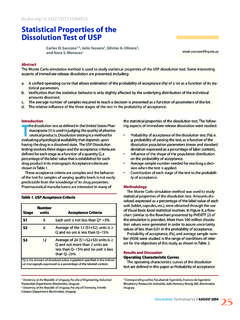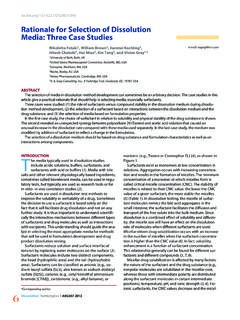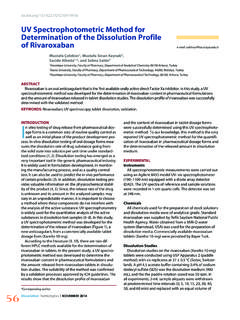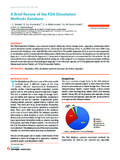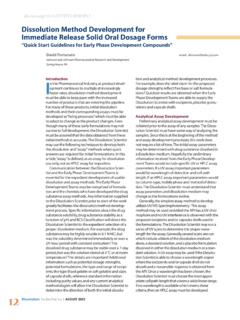Transcription of Dissolution of Gelatin Capsules: Evidence and …
1 6 AUGUST 2017 INTRODUCTIONC ross-linking is a common problem for solid oral dosage formulations filling hard Gelatin capsules (HGC) and soft Gelatin capsules (SGC), as well as for Gelatin -coated tablets. Cross-linking directly impacts the capsule product during in vitro Dissolution drug release testing , resulting in slower or incomplete release of the drug or no release at all. The USP General Chapters Dissolution <711> (1) and Disintegration and Dissolution of Dietary Supplements <2040> (2) allow the addition of enzymes to the Dissolution medium when the dosage forms do not conform to the Dissolution acceptance criteria due to Gelatin cross-linking. Recent revisions in these two USP chapters (which became official on May 1, 2016) further addressed current challenges regarding enzyme use in the Dissolution medium and provided new recommendations to overcome the challenges associated with the use of enzymes (3).
2 The recommendations covered three aspects. First, they speak to the choice of enzymes that may be used based on the pH of the Dissolution medium, recommending pepsin for pH equal to or below , papain or bromelain for pH above and below , and pancreatin for pH equal to or above Secondly, they state both the enzyme activity and amount to be added to the medium should be determined. Thirdly, they indicate a pre-treatment procedure should be used when the Dissolution medium contains a surfactant or any other ingredient known to denature the enzyme in use. Figure 1 shows the workflow and decision tree for Gelatin capsule Dissolution based on the USP general chapter <711> (1).Before following the USP recommendations to use enzymes for the Dissolution of cross-linked Gelatin capsules, it is important to confirm Evidence of cross-linking as the cause of a Dissolution run failing to meet the expected acceptance criteria.
3 The recently revised USP <711> (1) provides guidance on this, stating that, because of Evidence of the presence of cross-linking, the Dissolution procedure should be repeated with the addition of enzymes to the medium. This clarifies the older version of USP <711> chapter (4) that did not exclusively link Gelatin capsule Dissolution failure to the presence of cross-linking in the Gelatin . This lack of clarity may have led an analyst to assume that enzymes could be used for any failure, even those not related to Gelatin cross-linking. This misunderstanding could be problematic Dissolution of Gelatin Capsules: Evidence and Confirmation of Cross-Linking Xujin Lu*and Pankaj ShahDrug Product Science and Technology, Bristol-Myers Squibb Company, New Brunswick, NJ, USAABSTRACTC ross-linking is a common problem in the Dissolution of Gelatin capsules.
4 Cross-linking is characterized by a bridge across the peptide backbone of the Gelatin molecule which creates water insoluble membranes or pellicles during Dissolution testing . The chemical covalent bonding between Gelatin chains is typically triggered by catalytic amounts of aldehyde and/or from exposure to high temperature and humidity. Cross-linking Gelatin capsules results in a slower release of the drug or no release at all in common Dissolution media. If the Gelatin capsule Dissolution fails acceptance criteria due to Evidence of cross-linking, the US Pharmacopeia allows the use of enzymes in the Dissolution medium and requires two-tier Dissolution testing . Studies have shown that drugs from cross-linked capsules are available in vivo to the patient, justifying the use of enzymes in the in vitro Dissolution test.
5 The literature contains several examples supporting Evidence of cross-linking. However, confirming the degree of cross-linking continues to be a practical challenge due to a lack of quantitative procedures for measuring the extent of cross-linking and variability in options for formulations, excipients, level and types of stresses, and the experience level of the analysts. This article reviews the methodologies to confirm the Evidence of cross-linking such as visual observation, capsule shell switch test, and spectroscopic determination of cross-linking, with an aim to facilitate the discussion and establishment of an acceptable standard : Gelatin capsule, Dissolution , Gelatin cross-linking, cross-linking identification, spectroscopic Evidence of : 2017for justifying enzyme use for quality control release or stability Dissolution testing .
6 Although the recently revised USP <711> provided much-needed clarification on Gelatin cross-linking related Dissolution failure, it still omits the importance of clarification on how the Evidence of the cross-linking is documented, and what constitutes sufficient documentation and justification practices for the use of an enzyme, especially for testing Good Manufacturing Practice (GMP) samples, that is, marketed product stability samples and/or clinical re-assay samples once they fail to meet the in vitro Dissolution acceptance criteria. This article reviews the literature describing Evidence of cross-linking and methodologies to confirm Gelatin cross-linking. A brief overview of the background of Gelatin capsule cross-linking and the history of related studies is followed by a discussion on the use of Evidence , Figure 1.
7 A flowchartof Gelatin capsule Dissolution based on USP <711>.aa<711> Dissolution . In The United States Pharmacopedia and National Formulary USP 37-NF 32; 2014 (1).8 AUGUST 2017methodologies for confirmation, and the possibility of establishing an acceptable regulatory procedure regarding this OVERVIEW OF Gelatin CAPSULECROSS-LINKING AND RELATED STUDIESG elatin is a mixture of amino acids and peptides derived from collagen through hydrolysis (5, 6). Gelatin cross-linking occurs due to chemical reactions between the amino acids or peptide chains of Gelatin . The most common type of reaction involves the amine group of a lysine and a similar amine group on a neighbor molecule and forms a strong covalent bond. The reactions can be triggered by trace level of aldehydes present in excipients or the active pharmaceutical ingredient (API), or because of the degradation of any component of the formulation or packaging material.
8 It also can occur under certain stressed conditions, such as high temperature and humidity. Once the cross-linking starts, it does not stop even when the cause is removed. Cross-linking and Impact to Gelatin Capsule DissolutionChanges affecting the in vitro Dissolution of Gelatin capsules due to exposure to high humidity conditions were reported as early as the 1970s (7 9). More comprehensive studies were conducted in the 1980s (10 15) including observations for both HGC and SGC that cross-linking alters the physiochemical properties of the Gelatin capsule shells and generate a water-insoluble film or pellicle around the Gelatin capsule shell, on the inside or outside surfaces, or both. The Dissolution rates of the capsule formulations were significantly retarded when the cross-linking occurred (16).
9 A review article by Digenis et al. in 1994 (17) examined the mechanistic rationalizations of Gelatin cross-linking under conditions that are relevant to pharmaceutical conditions and summarized the chemistry of Gelatin cross-linking under elevated temperature and high humidity conditions, as well as the chemical interactions between Gelatin and aldehyde. While the impact of cross-linking on the Dissolution of Gelatin capsules attracted much attention, many efforts have been made to understand the relevance of the in vitro Dissolution of cross-linked Gelatin capsules to their in vivo performance (17 20). Studies were conducted to determine the effect of prolonged storage conditions on the bioavailability and clinical efficacy of drugs in Gelatin capsules. Cases were also reported in which the bioavailability of the drug from the stressed capsules did not significantly alter in vivo performance when compared to freshly prepared capsules (10, 20 23).
10 A comparison of the in vitro Dissolution rate of drug release from stressed Gelatin capsules with their in vivo performance has been reported (5).Establishment of Two-tier Dissolution TestExtensive studies have been conducted to determine if gastrointestinal tract enzymes, including pepsin and pancreatin, could digest the cross-linked Gelatin and overcome the adverse effect on capsule Dissolution and, in turn, drug release. Results confirmed the slower drug release noted in in vitro Dissolution due to stressful storage conditions of Gelatin capsules, such as high humidity and temperatures and severe light, were virtually eliminated when the products were tested in Dissolution media containing enzymes (24, 25). Based on these findings, a recommendation was made to include enzymes in the USP test medium for the special evaluation of aged Gelatin capsules (26) in in vitro Dissolution testing .
